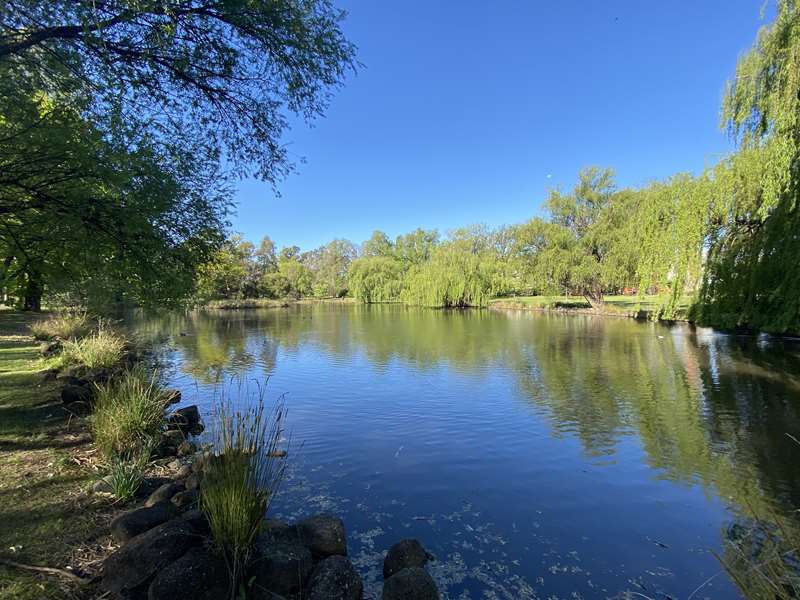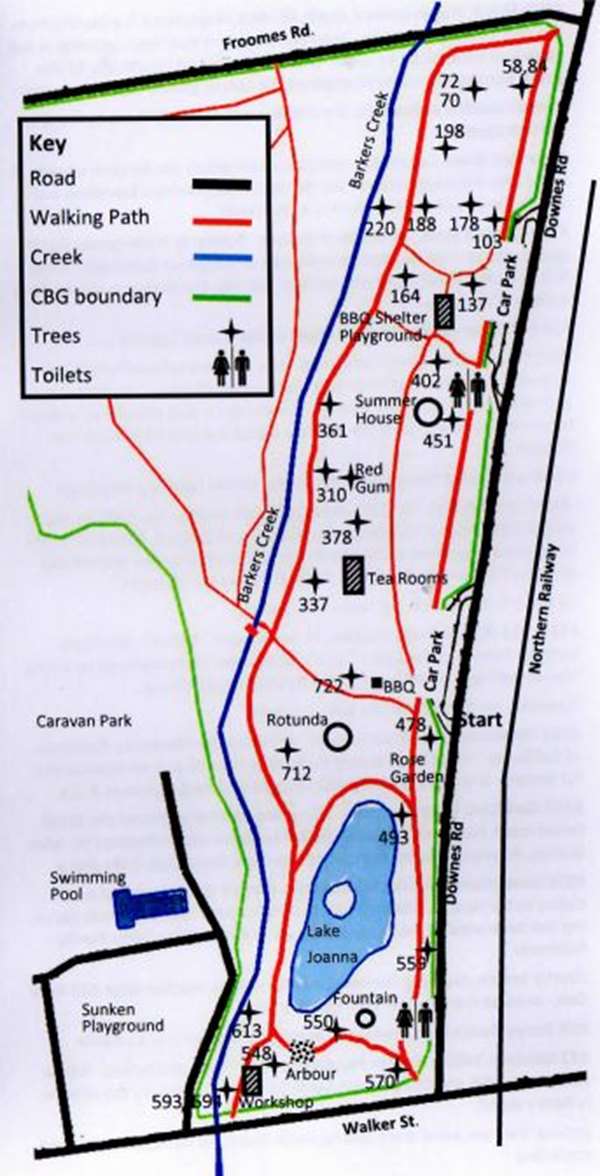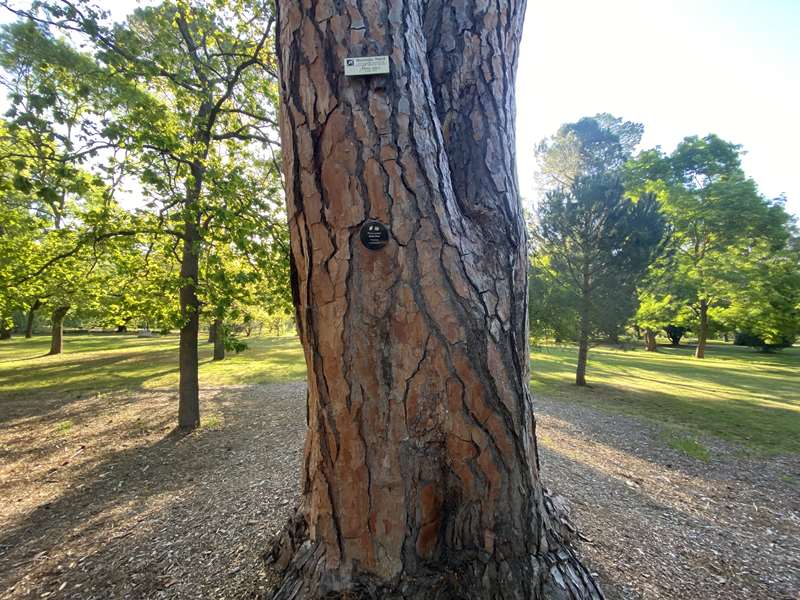Castlemaine Botanical Gardens Significant Trees Walk


A self-guided walk of 1.8 km through the Castlemaine Botanical Gardens.
These Gardens were established in 1860, shortly after the main Gold Rush, and have been placed on the Victorian Heritage Register. The area was once marred by numerous holes left by the miners. The redoubtable Baron Ferdinand von Mueller provided much of the material for the earlier plantings, some of which can still be found in the Gardens.
The National Trust has placed a number of trees on the State Regis-ter of Significant Trees, while an additional 7 are regarded as significant although not registered. There is a broad and interesting range of tree species in the Gardens, including oaks, elms and 8 different species of pine. In 1984-5 the Melbourne Botanic Gardens Rejuvenation Subcommittee identified most of the trees and some shrubs with numbers on small metal tags attached to the trunks. However many of these tags have disappeared over the years, so in 2021 a new tree register was established and new numbered metal tags were attached to trees. Significant trees have been provided with clear labels.
Registered trees are marked *. Significant trees are marked (S)
The walk begins from the car park near the Rose Garden off Downes Road.
Castlemaine Botanical Gardens Significant Trees Walk Map

The walk begins from the car park next to the Rose Garden and heads south, in a clockwise direction. The first tree on the left is a
#478 Mourning Cypress, Cupressus funebris, while a few metres further on is a
#479 Sycamore, Acer pseudoplatanus. On the N.E edge of the lake are two young trees of
#493 Bald Cypress, Taxodium distichum, from S.E. USA. Just before the third picnic table after the Rose Garden, over near the fence on the left you will see a
#559* Mimosa Bush, Vachellia farnesiana, formerly Acacia farnesiana. A somewhat misshapen but also prickly specimen. A member of the Pea family. Originally from Central America it has become a problem in Northern Australia. Acacia means thorns but few Australian Acacias have thorns. African species have thorns to deter grazing animals such as giraffes.
Continue on towards the main gates, cast in the foundry across the road and installed in 1878. Nearby is the fountain which was also in-stalled in 1878 and refurbished in 2011 by a local foundry. Grouped around the gates are a number of registered
#552, 570-573* Camperdown Elms, Ulmus glabra "Camperdownii". Every tree in the world of this species is a bud from the original branch of a tree found growing along the ground discovered at Camperdown House at Dundee in Scotland circa 1840, and grafted onto suitable stock, usually a Wych Elm. This group was planted in the 1870's.
Turn now to the west, on the right of the path is found an
#550* Indian Bean Tree, Catalpa bignonioides, the largest example of its kind in Victoria. It is registered but unlabelled. Continue on through the Wisteria arbour to reach on the left two
#548, 549* Oriental Planes, Platanus orientalis. This is frequently plant-ed as a street tree because of its resistance to pollution. To the south of the workshop and on the west of the path are two
#593, 594 Chilean Pepper Trees, Schinus polygama. Head north now beside the lake. On the left is a
#613* Large-leaved Linden, Tilia platyphyllos, only 3 of which are believed to be in cultivation in Victoria.
Lake Joanna on the right was formerly the course of Barkers Creek which was diverted and straightened. The cut-off creek bed was excavated using prison labour in 1878 and the lake named after the wife of the Mayor. In 2011 it underwent a facelift with rocks put in place to reduce erosion. When it was drained and excavated, the trucks working on the bottom were out of sight from a short distance, showing that the lake is fairly deep in parts.
On the far side of Barkers Creek is the 'Sunken Playground', which was known, until 1938, as Lake Augusta. It was referred to by locals as Lake Disgusta because of its rather unpleasant smell!
In the lawn to the north of the lake is a solitary
#712 Aleppo Pine, Pinus halepensis, one of several fine specimens in these Gardens. It is closely related to the Turkish Pine, Pinus brutia, which was the original "Lone Pine" of Gallipoli. The needles of P. brutia are considerably longer although P. halepensis is often planted at Lone Pine memorials. In South Australia it does so well that it is regarded as a weed.

On the left is the old fish hatchery and a footbridge across Barkers Creek leading to the Western extension of the Gardens.
On the right now are some
#333-337(S) Rough-barked Apple Myrtles, Angophora floribunda, from the east coast of Australia. Empress Josephine had them growing in her garden at Malmaison by 1804. It is closely related genetically to the genus Eucalyptus, but in Angophora the leaves grow in opposite pairs.
Further north is a plaque to the Old Nursery with reference to the large old (untagged)
River Red Gum, Eucalyptus camaldulensis which can be seen ahead. It is the only remaining tree in the Gardens that predates European arrival. To the left of the Red Gum is a very large
#310 Spotted Gum, Corymbia maculata. Formerly in the genus Eucalyptus, this species has been transferred to the genus Corymbia. A native of Queensland, NSW and eastern Victoria, the timber is valued for a variety of purposes.
A little further north and to the right under a large Cypress is a
#361* Jersey Elm, Ulmus sarniensis, only two examples of which are known in Victoria. The other is in the Kyneton Gardens. In 1815 it was said to be confined to the island of Guernsey. It was popular as a street tree in the U.K. but has been virtually wiped out there by Dutch Elm disease.
Continue on past the playground where, on the right is a very large
#164* English Oak, Quercus robur, planted on May 26, 1863 by municipal dignitaries to celebrate the marriage of Edward, Prince of Wales to Princess Alexandra of Denmark. It is believed to be the second largest in Victoria and is the oldest planted tree in the Gardens.
To the left of the path are some very elderly
#220, 221 (S) Lombardy Poplars, Populus nigra "Italica", significant because they once formed a "wall". Most have been replaced by a new row of saplings, raised and planted by the Friends Group.
Opposite, on the right of the path is a large
#188 Monterey Pine, Pious radiata, native to the Monterey Peninsula of California. It has been widely planted in Victoria as a windbreak and for timber. It is quick growing and drought resistant. Close to it is a
#187 Cork Oak, Quercus suber. Occurring naturally around the Mediterranean it has been cultivated for centuries to make stoppers for wine bottles. As you approach the corner there are more Cork Oaks and a
#198 Candleberry Myrtle, Myrica faya, a small muitistemmed tree native to the Azores, Madeira and Canary Islands. The waxy fruit cover-ing has been used to make candles as described in "The Swiss Family Robinson".
Shortly before rounding the bend, on the right is another large
#32 Cork Oak. Around the bend on the right is a large
#70 Bunya Bunya Pine, Araucaria bidwillii. Close to it is a smaller
#72 Western Yellow Pine or Ponderosa Pine, Pinus ponderosa. Native to western USA and Canada, the name Ponderosa refers to the relatively heavy wood. Around the next bend and heading south there are two multi-stemmed spreading
#58, 84 (5) Carob Beans, Ceratonia siliqua. The ground-up pod has been used as a chocolate substitute.
The word carat comes from the Greek word for carob as the beans were used to measure gold. 24 beans equalled a particular pure gold Roman coin, hence the name 24 carat gold.
On the right of the path, before the playground is a small
#103 (S) Japanese Plum Yew, Cephalotaxus harringtonia "fastigata" . It resembles an English Yew. Over to the right is a large
#178 Maritime Pine, Pinus pinaster. The name "pinaster" translates as "a poor imitation of a pine". A native of the Mediterranean region, it is the source of Pycnogenol which protects against harmful free radicals and boosts the immune system. It is an important timber tree in its region. It has long needles in pairs and is one of several fine specimens in the gardens.
Between here and the barbecue shelter are several
#137-139* Stone Pines, Pinus pinea (or Italian Pine). It is the source of the pine nuts used in cooking, and has been cultivated around the Mediterrane-an for 6000 years. The cones take 36 months to mature, longer than any other pine.

Between them and the fence on the left is another
#134 Bunya Bunya Pine, Araucaria bidwilli. Native to 5.E. Queensland, its distribution is now rather restricted. The large, nutritious nuts may once have fed dinosaurs.
To the south of the playground are
#403*, 404* two large Stone Pines, more recently classified.
Around the base of the second Stone Pine is a large bush used by children as a cubby house. This is a
#402 Kuni Bush, Rhus undulata, a member of the family Anacardiaceae, which also includes Cashew, Pistachio and Mango. The Chilean Pepper also belongs to this family.
Continue along the central path between several Stone Pines. On the left is the Summer House that was rebuilt by The Friends of the Gardens on the site of the original building. For many years the site was marked only by the remains of the asphalt floor.
To the east of the Summer House is a large
#451. Canary Island Pine, Pious canariensis, the only one of its kind in the gardens. Endemic to the Canary Islands it is the most fire-resistant conifer.
Approaching the recently refurbished former Tea Rooms, another very large classified Stone Pine is passed before another pine may be observed further to the right, this one with very pale bark. This is a
#378 Corsican Pine, Pious nigra var maritima, a widespread Mediterranean species. Despite the name, the greatest range is actually found in Turkey where it is used to cure acne, common cold, osteomyelitis and viral infections. An important timber species in the U.K, in N.Z. it is regarded as an invasive noxious weed.
To the south of the Tea Rooms near the transverse path and close to a large
#723 Bhutan Cypress, Cupressus torulosa, is a
#722 Plum Pine, Podocarpus elatus. Unlike other conifers this species does not have a cone, but bears a single seed which is attached by a fleshy stem resembling a small plum that was eaten by the aborigines. Only the female tree bears these "fruits."
The walk ends back at the car park. We hope you have found your time in the Gardens to be interesting and enjoyable.
Photos:
Location
Downes Road, Castlemaine 3450 View Map








